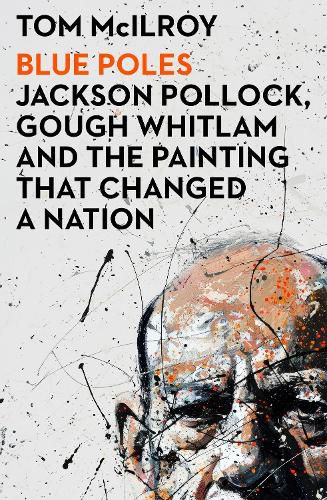Readings Newsletter
Become a Readings Member to make your shopping experience even easier.
Sign in or sign up for free!
You’re not far away from qualifying for FREE standard shipping within Australia
You’ve qualified for FREE standard shipping within Australia
The cart is loading…






In 1973, the Australian government bought Jackson Pollock's Blue Poles for A$1.4 million for the National Gallery of Australia.
Blue Poles: Jackson Pollock, Gough Whitlam and the painting that changed a nation tells the story of how Jackson Pollock rose to fame, how the record-setting purchase of Blue Poles sparked a media sensation and controversy both in Australia and the United States, and all the successes and turbulent turns in between.
Blue Poles provides insights into Pollock's movements within art circles, which included Peggy Guggenheim and his contemporaries Rothko and de Kooning, as well as the relationship with his artist wife Lee Krasner, who was his biggest champion while also bearing the brunt of Pollock's personal troubles. And while Pollock was known for inspiring hope for a new art tradition outside of Europe, larger than life accounts surrounded his artistic practice, including questions around the creation of Blue Poles, which some believe to be true and others pure myth-making.
It was Gough Whitlam's commitment to the arts and cultural capital that would see the work originally called Number 11 (1952) move to another continent where brows were raised - concerns centred around the worth of a work by 'Jack the Dripper' and the value of local artistic output among others.
Blue Poles: Jackson Pollock, Gough Whitlam and the painting that changed a nation is the compelling account of one of Australia's most prized paintings and the controversies that followed it, from its NYC origins to the hallowed halls of the National Gallery of Australia.
$9.00 standard shipping within Australia
FREE standard shipping within Australia for orders over $100.00
Express & International shipping calculated at checkout
In 1973, the Australian government bought Jackson Pollock's Blue Poles for A$1.4 million for the National Gallery of Australia.
Blue Poles: Jackson Pollock, Gough Whitlam and the painting that changed a nation tells the story of how Jackson Pollock rose to fame, how the record-setting purchase of Blue Poles sparked a media sensation and controversy both in Australia and the United States, and all the successes and turbulent turns in between.
Blue Poles provides insights into Pollock's movements within art circles, which included Peggy Guggenheim and his contemporaries Rothko and de Kooning, as well as the relationship with his artist wife Lee Krasner, who was his biggest champion while also bearing the brunt of Pollock's personal troubles. And while Pollock was known for inspiring hope for a new art tradition outside of Europe, larger than life accounts surrounded his artistic practice, including questions around the creation of Blue Poles, which some believe to be true and others pure myth-making.
It was Gough Whitlam's commitment to the arts and cultural capital that would see the work originally called Number 11 (1952) move to another continent where brows were raised - concerns centred around the worth of a work by 'Jack the Dripper' and the value of local artistic output among others.
Blue Poles: Jackson Pollock, Gough Whitlam and the painting that changed a nation is the compelling account of one of Australia's most prized paintings and the controversies that followed it, from its NYC origins to the hallowed halls of the National Gallery of Australia.
I’m going to go out on a sturdy limb and say, from the outset, that I LOVE Blue Poles. It’s a terrific painting. I have great memories of a school trip to Canberra – exactly as Gough Whitlam wished for schoolkids – to see this national treasure. Tom McIlroy’s jaunty full-length debut offers readers a more contemporary look at this acquisition, now that some 50 years have passed, and the dust has settled. With the benefit of that distance, younger generations can shake their heads with alacrity at the moral panic that surrounded the purchase of this magnificent painting.
You’ll mostly know McIlroy from his shorter-form journalism, but here he demonstrates that he’s more than capable of turning his hand to complex subjects. He does a fine job distilling the essence of American Modernism and forays into Abstract art, and Abstract Expressionism for general readership.
The first half of the book contextualises Jackson Pollock’s life, and his myriad struggles: with alcoholism, mental health, and impostor syndrome to name a few, and within artist and patron circles, giving due recognition to the role of Lee Krasner. As Pollock’s wife, she supported him fully, often coaxing him from an alcoholic fug back into everyday life, managing to balance all of this with her own successful career as an artist.
The middle section is devoted to the Blue Poles artwork itself, with a good account of its history prior to arriving in Canberra, while the final section is devoted to the painting’s acquisition and the resulting flap. While Whitlam seized on the big moment he was offered when he greenlit this purchase for the nation, credit is also due to James Mollison for his brilliant raison d’être when building the collection in that first decade. The national gallery didn’t need to ape the state’s collections, which is why the holdings of 20th-century American art are so strong. This is a terrific book, a must-read for the year!
See what the Readings’ team have to say on the blog, discover related events and podcast episodes.
Discover our latest new release fiction and nonfiction books.
Discover new Australian nonfiction books at Readings, with biography, memoir, essays and analysis.
Discover new nonfiction books at Readings, with biography, memoir, essays and analysis.